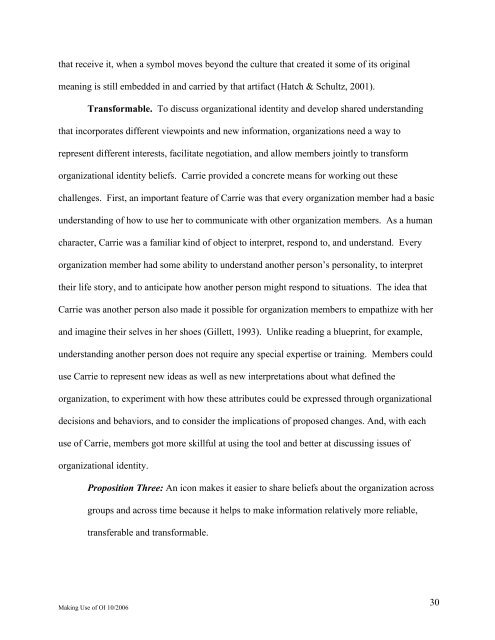Making Use of Organizational Identity - Authentic Organizations
Making Use of Organizational Identity - Authentic Organizations
Making Use of Organizational Identity - Authentic Organizations
You also want an ePaper? Increase the reach of your titles
YUMPU automatically turns print PDFs into web optimized ePapers that Google loves.
that receive it, when a symbol moves beyond the culture that created it some <strong>of</strong> its original<br />
meaning is still embedded in and carried by that artifact (Hatch & Schultz, 2001).<br />
Transformable. To discuss organizational identity and develop shared understanding<br />
that incorporates different viewpoints and new information, organizations need a way to<br />
represent different interests, facilitate negotiation, and allow members jointly to transform<br />
organizational identity beliefs. Carrie provided a concrete means for working out these<br />
challenges. First, an important feature <strong>of</strong> Carrie was that every organization member had a basic<br />
understanding <strong>of</strong> how to use her to communicate with other organization members. As a human<br />
character, Carrie was a familiar kind <strong>of</strong> object to interpret, respond to, and understand. Every<br />
organization member had some ability to understand another person’s personality, to interpret<br />
their life story, and to anticipate how another person might respond to situations. The idea that<br />
Carrie was another person also made it possible for organization members to empathize with her<br />
and imagine their selves in her shoes (Gillett, 1993). Unlike reading a blueprint, for example,<br />
understanding another person does not require any special expertise or training. Members could<br />
use Carrie to represent new ideas as well as new interpretations about what defined the<br />
organization, to experiment with how these attributes could be expressed through organizational<br />
decisions and behaviors, and to consider the implications <strong>of</strong> proposed changes. And, with each<br />
use <strong>of</strong> Carrie, members got more skillful at using the tool and better at discussing issues <strong>of</strong><br />
organizational identity.<br />
Proposition Three: An icon makes it easier to share beliefs about the organization across<br />
groups and across time because it helps to make information relatively more reliable,<br />
transferable and transformable.<br />
<strong>Making</strong> <strong>Use</strong> <strong>of</strong> OI 10/2006<br />
30


